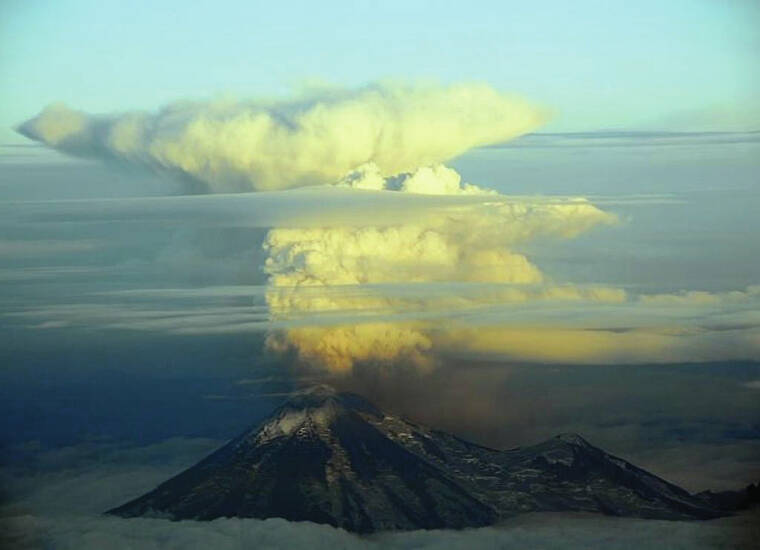As magma migrates to shallow depths, it causes the volcano to grow and expand, resulting in upward and outward ground displacements that can be seen on local ground deformation instruments. The increased pressure below the surface — due to moving magma — can cause the surrounding rocks to break, resulting in small earthquakes. But do volcanoes always show such clear indicators that they may erupt?
Alaska is home to fifty-four active volcanoes and accounts for 80% of active volcanism in the United States. Before many recent eruptions in Alaska, increases in the number of earthquakes, the appearance of volcanic tremor, and/or rapid ground displacements were observed. These changes are called precursors and instrumental monitoring of them can help forecast volcanic eruptions. They are particularly important in Alaska, where weather can prevent other visible precursors, such as steam, volcanic gas, and thermal anomalies, from being detected by satellites and cameras.
Different types of precursory behavior can occur on scales of months, weeks, days, or even hours before an eruption. However, such indications of impending eruption are not always observable at all Alaskan volcanoes. Pavlof Volcano, an approximately 8,000 feet high stratovolcano located within the Aleutian volcanic arc, has remained elusive in yielding clues to impending eruption.
Recent Pavlof eruptions in 2013, 2014 (2 eruptions), and 2016 haven’t shown precursory earthquake activity, and the 2007 eruption showed only hours of precursory earthquake activity. Further, satellite observations of the volcano show that past eruptions have occurred here without causing precursory ground deformation.
Studies of lavas from past eruptions at Pavlof show that the magma feeding these eruptions is stored deep (greater than 20 km, or 12 miles, beneath its surface). When Pavlof isn’t erupting, magma likely remains at depth as gases accumulate within this deep magma storage system.
The gas-entrained magma is thought to ascend rapidly to the surface just prior to eruption at Pavlof. Deep storage followed by rapid ascent of magma from depth immediately preceding eruption complicates our ability to observe longer-term eruption precursors such as shallow earthquake activity and ground deformation.
The gas-rich nature of magma at Pavlof commonly results in explosive eruptions, creating ash plumes that reach high altitudes. For example, ash plumes between about 33,000 and 56,000 feet high were generated during eruptions at Pavlof in 1986, 2014, and 2016.
These ash plume heights fall in line with the typical cruising altitudes of commercial aviation flights. Since volcanic activity at Pavlof occurs frequently and can produce ash plumes of significant height, the volcano poses a major hazard to the 60,000 people that fly overhead or downwind of the Aleutian arc each day.
Scientists at the Alaska Volcano Observatory (AVO) carefully monitor the Aleutian arc due to the hazards posed to aviation by Pavlof and other active volcanoes there.
Currently, AVO is completing a project to upgrade existing ground-based equipment used to monitor these volcanoes to improve their ability to forecast volcanic eruptions. Following recent upgrades, in July 2021, AVO scientists noticed the onset of volcanic tremor on Pavlof’s network of seismic instruments indicating the movement of gas, magma, and other fluids in the subsurface. The volcano aviation color code for Pavlof was raised from GREEN to YELLOW, indicating the volcano was showing signs of volcanic unrest. A month later, Pavlof entered a period of eruption that is ongoing and the color code was raised to ORANGE, indicating an eruption with minor ash emissions.
The success in forecasting Pavlof’s current eruption suggests that improvements in the ground-based monitoring equipment near the volcano may have allowed AVO scientists to identify tremor that possibly went undetected in previous eruptions.
Time will tell whether pre-eruptive volcanic tremor is a tell-tale sign of impending eruption at Pavlof. However, improvements made to ground-based monitoring instruments at this and other volcanoes give AVO scientists a stronger set of tools to potentially forecast eruptions.
Volcano Activity Updates
Kilauea volcano is erupting. Its USGS Volcano Alert level is at WATCH. Kilauea updates are issued daily.
Lava continues to erupt from a single vent in the western wall of Halemaʻumaʻu crater. All lava activity is confined within Halemaʻumaʻu crater in Hawaii Volcanoes National Park. Sulfur dioxide emission rates remain high and were estimated at around 3,600 tonnes per day on Oct. 28, 2021. Seismicity is elevated but stable, with few earthquakes and ongoing volcanic tremor. Summit tiltmeters have remained relatively flat over the past week.
Mauna Loa is not erupting and remains at Volcano Alert Level ADVISORY. This alert level does not mean that an eruption is imminent or that progression to an eruption from the current level of unrest is certain. Mauna Loa updates are issued weekly.
This past week, about 62 small-magnitude earthquakes were recorded below the summit and upper elevation flanks of Mauna Loa — the majority of these occurred at shallow depths less than 6 miles. GPS measurements show no major deformation over the past week. Gas concentrations and fumarole temperatures at both the summit and at Sulphur Cone on the Southwest Rift Zone remain stable. Webcams show no changes to the landscape.
There were four events with three or more felt reports in the Hawaiian Islands during the past week: a magnitude-3.4 earthquake 2 miles south-southwest of Pahala on Nov. 2 at 5:07 p.m.; a magnitude-3.2 earthquake 1 mile south of Pahala on Nov. 2 at 2:27 a.m.; a magnitude-3.3 earthquake 4 miles east of Pahala on Oct. 31 at 8:59 p.m.; and a magnitude-3.4 earthquake less than a mile south-southeast of Pahala on Oct. 31 at 4:40 a.m.
Visit https://www.usgs.gov/observatories/hawaiian-volcano-observatory for past Volcano Watch articles, Kilauea and Mauna Loa updates, volcano photos, maps, recent earthquake info, and more. Email questions to askHVO@usgs.gov.
Volcano Watch is a weekly article and activity update written by U.S. Geological Survey Hawaiian Volcano Observatory scientists and affiliates.



